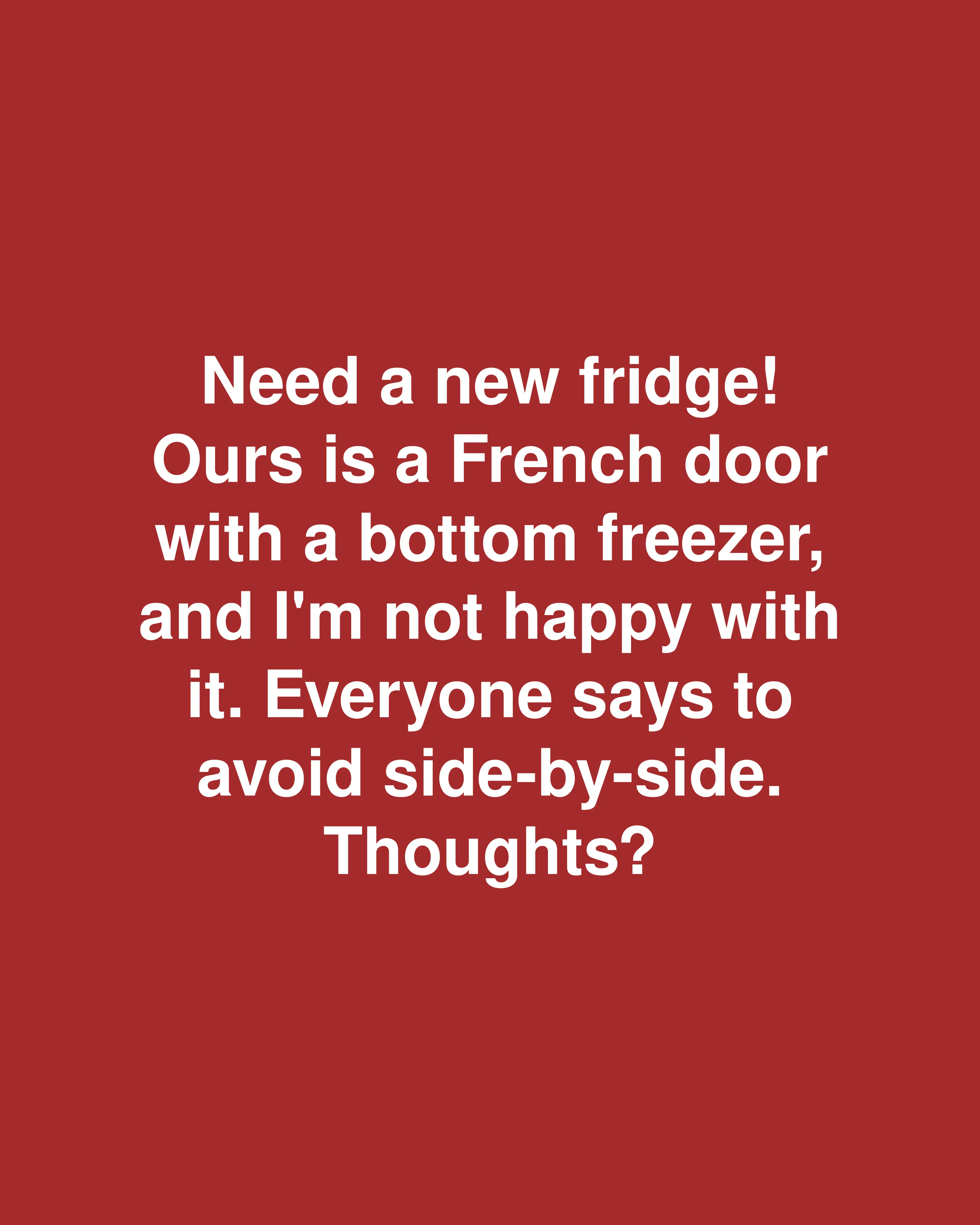Want to save this recipe?
Enter your email below and we’ll send the recipe straight to your inbox!
Finding Your Perfect Refrigerator: A Complete Guide to Configurations
Have you ever stood in front of an appliance store display, overwhelmed by the dizzying array of refrigerator options? You’re not alone. The refrigerator is arguably the most essential appliance in your kitchen, yet choosing the right configuration can feel like solving a complex puzzle of space, budget, and lifestyle needs.
Understanding Your Refrigerator Options
The configuration of your refrigerator—how the freezer and fresh food sections are arranged—impacts everything from your daily cooking routine to your grocery shopping habits. Each design offers distinct advantages and potential drawbacks that could make or break your kitchen experience.
French Door Refrigerators: Spacious and Stylish
French door refrigerators have become increasingly popular in modern kitchens, featuring two side-by-side doors on top and a pull-out freezer drawer below.
What You’ll Love
- Wider shelves that easily accommodate party platters and pizza boxes
- Eye-level fresh food storage that minimizes bending
- Energy efficiency from opening just one door at a time
- Stylish, contemporary appearance that enhances kitchen aesthetics
Potential Drawbacks
- Higher price point than traditional models
- Bottom freezer requires bending to access frozen items
- More complex mechanisms that might require maintenance
- Generally larger footprint that may not work in smaller kitchens
Side-by-Side Refrigerators: Convenient Access
Side-by-side models divide your refrigerator vertically, with the freezer on one side and fresh food storage on the other.
What You’ll Love
- Equal access to both freezer and refrigerator without bending
- Narrow door swing that works well in kitchens with limited clearance
- Often includes water and ice dispensers built into the door
- Good organization with multiple shelves in both compartments
Potential Drawbacks
- Narrow compartments that may not fit wide items like pizza boxes
- Less energy efficient due to vertical separation
- Sometimes less overall storage capacity than similarly sized models
- Ice makers can reduce available freezer space
Top-Freezer Refrigerators: Classic and Economical
The traditional configuration places the freezer compartment above the refrigerator section.
What You’ll Love
- Most affordable option on the market
- Simple, reliable technology with fewer parts to break
- Energy efficient design
- Balanced storage capacity between freezer and refrigerator
Potential Drawbacks
- Less convenient access to fresh foods (requires bending)
- Typically fewer features and organizational options
- More traditional appearance may not suit modern kitchens
- Often lacks amenities like water dispensers
Single-Door Refrigerators: Compact Solutions
These smaller units are perfect for apartments, offices, or as secondary refrigerators.
What You’ll Love
- Space-saving design for tight areas
- Lower upfront cost and energy consumption
- Portability for changing living situations
- Perfect for supplemental storage or specific uses
Potential Drawbacks
- Limited capacity that won’t serve larger households
- Tiny freezer compartment with inefficient cooling
- Fewer organizational features
- Basic temperature control options
Making the Right Choice for Your Kitchen
Assess Your Space and Layout
Before falling in love with any particular model, grab a measuring tape:
- Measure the height, width, and depth of your available space
- Allow at least 1-2 inches of clearance on all sides for ventilation
- Consider door swing clearance (especially for islands or narrow kitchens)
- Factor in traffic patterns in your kitchen
Pro tip: Use painter’s tape on your floor to outline the dimensions of models you’re considering. This visual reference helps you understand how the space will feel with the new appliance.
Analyze Your Food Storage Habits
Your lifestyle significantly influences which configuration will serve you best:
- Frequent entertainers benefit from the wide shelves of French door models
- Families who stock up on frozen goods might prefer side-by-side or top-freezer designs
- Those who prioritize fresh produce should consider models with specialized crisper drawers
- Households that rarely cook might do fine with smaller, simpler units
Balance Features with Budget
Refrigerator prices can range dramatically from $500 to $5,000 or more:
- Top-freezer models typically offer the most value (starting around $600-$900)
- Side-by-side refrigerators generally fall in the middle range ($1,000-$2,000)
- French door configurations command premium prices ($1,800-$4,000+)
- Consider long-term energy costs, not just purchase price
Common Refrigerator Selection Mistakes to Avoid
Overlooking Energy Efficiency
A refrigerator runs 24/7, making it one of your home’s biggest energy consumers. Look for ENERGY STAR certified models, which typically use 9% less energy than standard models. This small efficiency difference can save hundreds of dollars over the appliance’s lifetime.
Prioritizing Aesthetics Over Function
While a beautiful refrigerator enhances your kitchen, don’t let appearance trump practical considerations. That sleek glass-door model might look stunning in the showroom but prove impractical for your family’s storage needs or cleaning habits.
Neglecting Future Needs
Consider how your household might change during the refrigerator’s 10-15 year lifespan. Growing families may need more capacity, while empty-nesters might eventually prefer smaller models with specialized features.
Beyond the Configuration: Extra Features Worth Considering
- Temperature-controlled drawers for extending produce freshness
- Smart features that alert you to open doors or maintenance needs
- Fingerprint-resistant finishes for households with children
- Adjustable or customizable shelving for flexible storage
- Water filtration systems for clean drinking water
- Door-in-door access for frequently used items
Frequently Asked Questions
Which refrigerator configuration is most energy efficient?
Top-freezer models are typically the most energy-efficient design, followed by bottom-freezer models. Side-by-side refrigerators tend to use more energy due to their vertical separation of cold spaces.
How long should a new refrigerator last?
Most quality refrigerators should provide 10-15 years of reliable service. Simpler models with fewer features (like top-freezers) often have longer lifespans due to fewer complex components.
Is it worth paying extra for a smart refrigerator?
Smart features can add convenience through inventory tracking, remote temperature control, and maintenance alerts. However, the technology may become outdated before the refrigerator’s mechanical components wear out. Consider whether these features justify the premium price for your specific needs.
What’s the best configuration for small kitchens?
For truly compact spaces, single-door refrigerators or apartment-sized top-freezer models work best. In small but not tiny kitchens, counter-depth refrigerators (which align with cabinets) can provide a built-in look without sacrificing too much storage.
Your refrigerator is more than just an appliance—it’s the heart of your kitchen’s functionality. By understanding the strengths and limitations of each configuration, you can make an informed choice that enhances your daily life and complements your cooking style for years to come.


